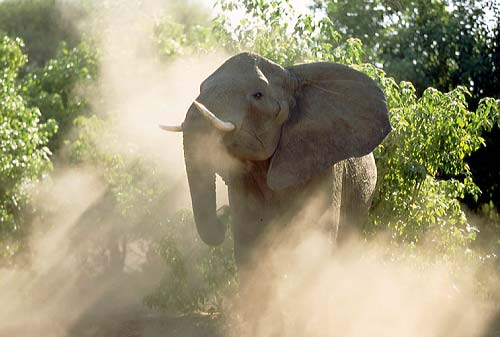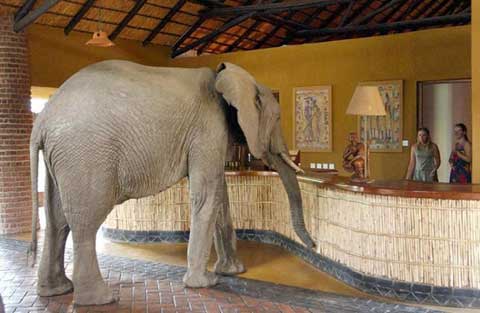
DNA Tests Show African Elephants Are Two Species
Hillary Mayell
for National Geographic News
August 24, 2001
Genetic fingerprinting shows that Africa's forest and savanna elephants are as different from one another as lions and tigers and should be considered as two genetically distinct species, an international group of researchers reports.
Up until now, elephants have been divided into two species—Asian and African. However, there has been considerable debate among experts as to whether the differences between Africa's forest and savanna elephants were significant enough to identify them as separate species. The DNA evidence, reported in the August 24 issue of the journal Science, provides a definitive answer to the long-debated controversy.
The finding has implications for both international law and conservation strategies.
If there are two species, there are both fewer elephants in each population and they're more endangered than previously assumed, according to Nicholas Georgiadis, a biologist at the Mpala Research Center in Kenya and co-author of the study.
Different Characteristics
Seventy years ago there were between three million to five million elephants in Africa. Today there are around 500,000 elephants in Africa. Forest elephants comprise around one-third of that number, living in the equatorial forests of central and western Africa. The savanna or bush elephant is found throughout the grassy plains and bushland of the continent.
Forest elephants are smaller and have straighter and thinner tusks, rounded ears, and a distinct skull shape.
The social structure of the two species also differs. The family units of savanna elephants typically contain about ten individuals. Sometimes several families join to form a clan with up to 70 members, led by a large female. Forest elephants live in much smaller groups.
The differences between the two have long been noted, says F.V. "Loki" Osborn, an elephant researcher based in Zimbabwe.
Raphael Ben-Shahar, an elephant expert at Oxford University, says, "Up until DNA fingerprinting tests, species were defined on the basis of morphological and anatomical differences." Using the old classification yardsticks, the forest elephant was merely a subspecies of the savanna elephant. However, there was widespread disagreement among taxonomists as to whether the differences between the two elephant types were significant enough to denote separate species, he says.
The DNA evidence should put the controversy to rest.
Major Implications
"The impact on management strategies if there are two elephant species in Africa is huge," says Ben-Shahar. "Now we will have two species that are less numerous than was thought before."
Being killed for their ivory and loss of habitat due to encroachment by humans are threats faced by both African species. However, recognition of their genetic distinctiveness will allow wildlife managers to fine-tune conservation strategies to best protect each species. Forest elephants are more threatened by logging, for instance, whereas agricultural expansion poses a huge threat to the elephants of the savanna.
In addition, forest elephant populations are smaller, and their ivory is highly prized for its hardness and pinkish color. "The difficulty in detecting poaching in the rain forest may put the forest elephant more at risk," says Osborn.
On the other hand, the elephants of the savanna face more friction with humans because they live where people prefer to live, unlike the forest elephant, says Ben-Shahar. But their accessibility may garner more of the conservation dollars.
"It [the savanna elephant] is the more appealing of the two species for tourists because it is bigger and easily found. Would you pay much to see a reclusive elephant shadow in the jungle?" asks Ben-Shahar.
Recognition of the forest elephant as a separate species also has legal implications. The African elephant, Loxodonta africana, is listed as endangered under the Convention on International Trade of Endangered Species (CITES, pronounced like nighties). There is some concern that under current treaty regulations, recognition of a second species could open a loophole that would allow poachers to exploit the ban on ivory trade.
The IUCN Species Survival Commission African Elephant Specialist Group does not plan to address the two-species issue until early next year, according to Leo Niskanen, program officer for the group.
Funding for the study was provided by the National Geographic Society, European Union, National Science Foundation, National Institutes of Health, and U.S. Fish and Wildlife Service.
For more news stories and many photo galleries about Africa's people and culture, animals and ecosystems, ancient civilizations, and scientific research, visit the National Geographic News Africa News Web site. Go>>

Scientist Finds that Plants Regulate Elephant Populations
David Braun
National Geographic News
(March 5, 2001)
Conventional wisdom among African conservationists has it that unless wild elephants are ruthlessly controlled by large-scale slaughter or relocation they will breed to such an extent that they will succumb to starvation—destroying much of their habitats, and as a result resident wildlife, in the process.
But, in a project supported by the National Geographic Committee for Research and Exploration, University of Oxford scientist Raphael Ben-Shahar has determined that in large nature reserves it is the environment that regulates elephant numbers and not the other way around.
According to Ben-Shahar the ecosystem of plants and consumers is fine-tuned and is essentially stable, and does not require human interference.
"There is no need to cull elephant herds to maintain an ecological equilibrium," he says. "Long before elephant populations exceed the carrying capacity and threaten the environment their breeding rate falls. This seems to be determined by a fall in nutrients in their food supply, suppressing elephants' reproduction system."
Ben-Shahar has spent ten years researching elephants' habitats in the Chobe and Okavango area of northern Botswana, near the border of Namibia in southern Africa. The elephant population of the region numbers 60,000 to 100,000, or about ten percent of the continent's total herd.
As elephants can increase their numbers by as much as five percent per year, conservationists fear that elephant populations can become so numerous that local habitats are unable to support the lumbering behemoths. The situation is exacerbated across Africa as human settlements have hemmed in wildlife sanctuaries and elephants are unable to roam in search of new pastures.
Through the Guts of Elephants
An adult pachyderm can munch its way through 330 to 440 pounds (150 to 200 kilograms) of vegetation a day. "Multiply that figure by 60,000 and you will realize that a staggering amount of biomass passes through the guts of northern Botswana's elephants," says Ben-Shahar.
"In the worst scenario, scientists fear that elephants could destroy their habitats and then die of hunger as they are unable to migrate across human settlements in search of alternative food supplies. In this scenario there is a limit to how many elephants and other animals a habitat can support.
"The commonly held notion is that elephants have the ability to alter habitats and the livelihood and success rate of other species and plants," Ben-Shahar says.
Rather than focusing directly on the elephants, Ben-Shahar centered his research on the vegetation of the region, studying all the factors that could impact the success of plants, including cycles of drought and fire.
Being heavy consumers of water (40 gallons/90 liters a day), elephants crowd the areas nearest the rivers and perennial waterholes during the dry seasons. In the rainy cycles they are more dispersed across the bushveld, using temporary waterholes in addition to the regular sources.
In the dry seasons, the vegetation nearest the perennial water sources naturally comes under a lot more pressure from the browsing animals, particularly elephants.
"Interestingly, I discovered that at zero distance from the water supplies there is large variation in the amount of damage to vegetation," Ben-Shahar says. "At some waterholes there was hardly any damage to plants, while at others the damage was substantial."
Closer inspection also revealed that what might be considered to be severe damage in the dry, winter months was in fact an optical illusion, as so many plants naturally shed their leaves.
Ben-Shahar further noticed that fire in the dry season caused major damage to plants. Those plants that recovered from fire sprouted from the ground up, making them particularly susceptible to small browsers.
Studying the different plant types in northern Botswana, Ben-Shahar also identified insects and disease as substantial causes of plant damage.
Elephants No Threat to Vegetation
By combining all influences on the success of plants, the scientist was able to draw up a comprehensive life history cycle of different species of vegetation and woodlands in particular. He determined that in northern Botswana the elephant herds were "nowhere close" to becoming a threat to the vegetation.
The prevailing view in the region is that elephants cause havoc and should be controlled.
"My research suggests that in the long term elephants will increase their numbers until they run into certain limiting factors, such as falling nutrients in leaves and soils, which in turn inhibit reproduction in elephants as well as other wildlife," says Ben-Shahar.
"After that the elephant population may decline a little, but basically they are in a fairly stable equilibrium with their food sources. If elephant numbers are growing then that is because of the availability on nutrients and food."
"So I came up with a nice scientific discovery. The question is now how can we use this information," he says.
An MBA graduate from Cornell University, Ben-Shahar is anxious to use business management techniques to create a win-win situation for the elephants and local farmers.
Ben-Shahar briefed the staff of the Department of Wildlife and National Parks, the custodians of wildlife in Botswana, on his findings and is active in a program to educate locals on the need to conserve and protect their wilderness heritage, including the elephants.
"The objective of my research was not really elephant biology but to create a win-win situation for wildlife and the local communities through an understanding of the dynamics of the environment," he says. "If the local people understand the limits of the environment, they can benefit from the yield of the natural assets without harming nature."
1 comment:
wow very interesting, I laugh many times when I read the scientific journal, because humans believe they already know everything, and they think the maths are perfect, how they can believe this, the math have been invented by humans.
------------------------------------------
Generic Viagra
Post a Comment